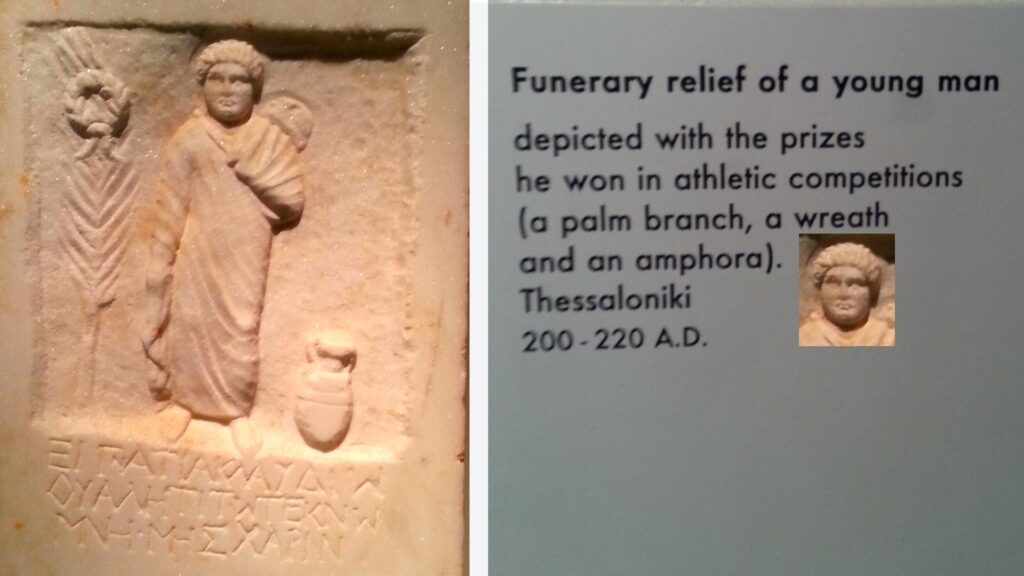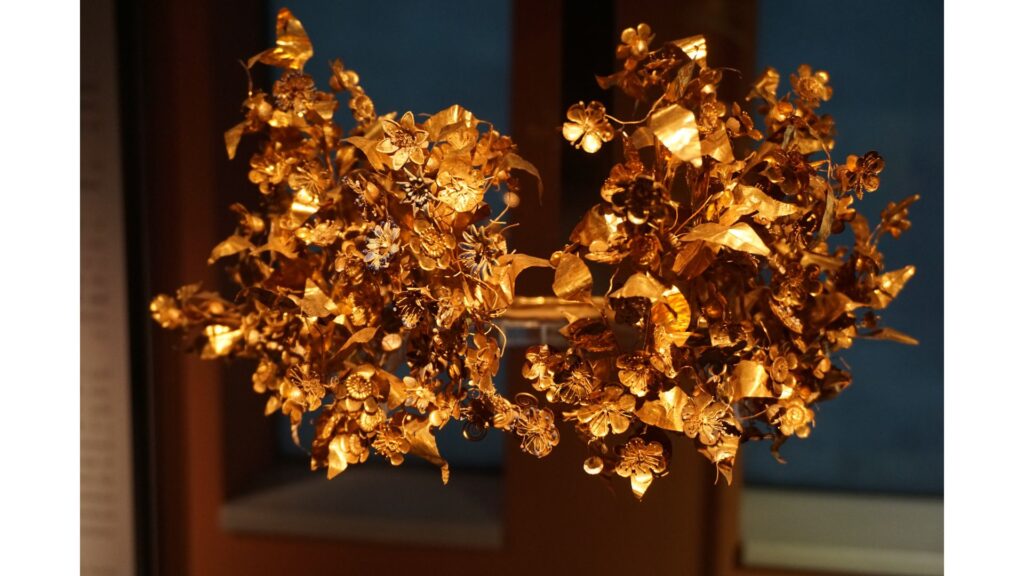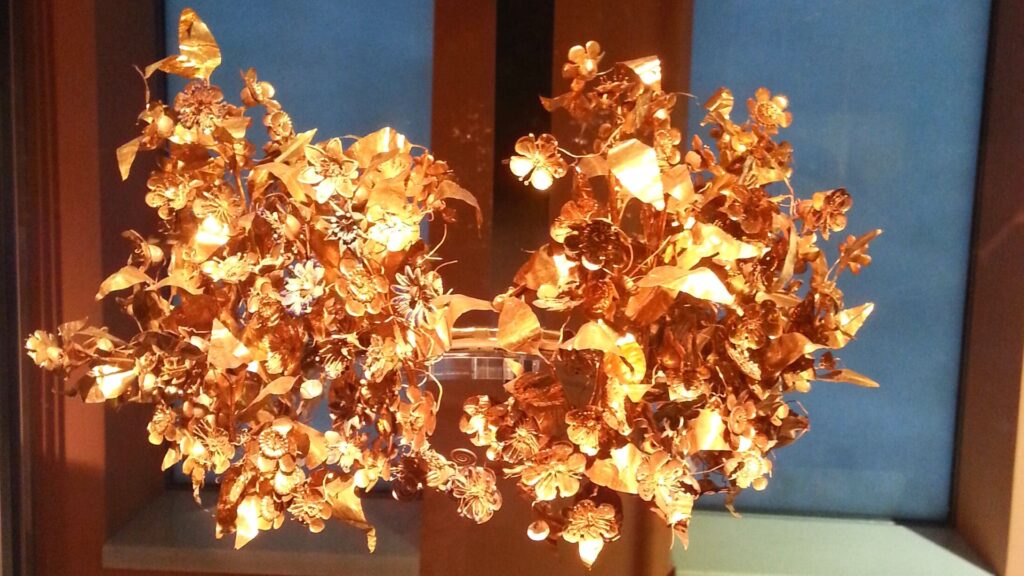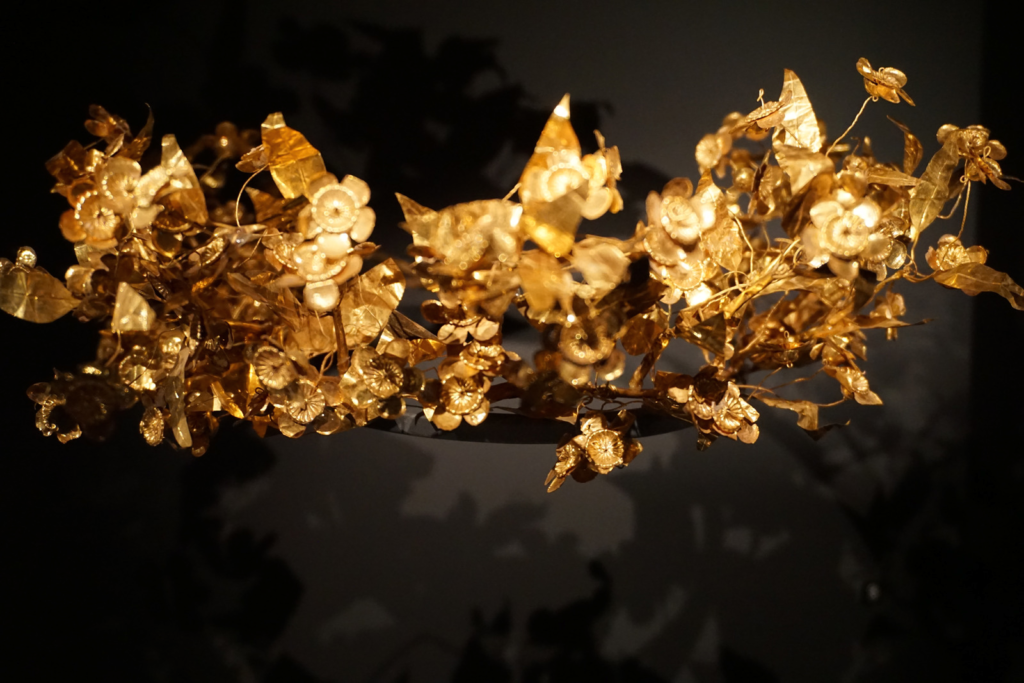Wreaths as Religious Symbols
At the Archeological Museum of Thessaloniki, let us look at the wreaths. Wreaths are religious symbols. Greek worshippers identified with their certain patron god in official presentations, not only for religious presentations, but also for social occasions, like weddings. On these occasions the worshippers dressed very well, of course, and they wore a wreath on their head, the wreath of the favorite plant of their god. Greek gods had favorite plants and animals.The wreath showed that they belonged to that worship. Not only the priests, but all of the people identified their worship in this way. This is important because this automatically identifies the wreath as a religious symbol.

In the New Testament both diadems and wreaths are mentioned, but unfortunately, in most New Testament translations the incorrect term most often used to translate wreaths and diadems into English is “crown.” This is an incorrect translation because crown as a term is not mentioned at all in the New Testament. A crown is the symbol of the political power of a king. And so, when you find in your English Bibles the term “crown”- ask yourself, what should be the correct translation? Is the correct translation, wreath, or diadem?
A Greek wreath is a religious symbol.
Now we have to say something here about the athletic life of the Greeks. The athletic lives of the Greeks was a part of the religious life. Greeks believed that their body was a gift given to them from the gods, to become the residence of the soul. Greeks recognized this whenever they had festivals, in the temples, and also in races. Any victory of a race was offered up as gratitude for using the body. For that reason, the athletic life was totally prohibited to Hebrew experience. All Jews were not allowed to participate because athletic life was considered a pagan religious covenant. Other people of the community participated spontaneously, though sometimes the races were a little bit more organized. The games were organized by temples and mostly had local character.
There were four temples among the Greek states which organized inter-Greek games for all the Greeks. The games were one of the major cultural ties of the Greeks. The Greeks were divided, never had a united state, and in many cases, fought each other. But the inter-Greek games drew them all together. The games were related with the peace process This is the main reason of the revival of the Olympic Games, the main athletic event for all the Greeks of antiquity.
Most of the races had local character and the temples offered local prizes. Temples were institutions with their own property and products. Temples had incomes. So, from the temple’s products they gave prizes to the winners. For example, in Athens, the games were dedicated to the goddess Athena, and the prize was a good amount of olive oil, a product with local Athenian significance.
It was not the same with inter-Greek games. The inter-Greek games were the games of the wreaths. The winners’ prize was a natural wreath from the sacred plant of the sanctuary. So, for example, the prize for the Olympic Games was a wreath of olive. The second most important Greek athletic games were the Isthmian games, organized in Corinth of the Temple of Poseidon. That prize was a wreath of pine. The third most important games were dedicated to Apollo, organized at the Oracle of Delphi. The wreaths was made of Laurel. And the last ones, the fourth, the Nemean games were dedicated to Zeus had a prize of a wreath made of celery.

So, you understand that each “prized” wreath was very, very perishable. The actual prize of these games was glory, nothing material. The wreath was just a blessing. It was definitely a religious symbol. The perishable wreath of the winners lasted a short time, actually a very short time.
But there was a person who wore, on his head, an imperishable wreath – not a common perishable wreath, but an imperishable wreath. This person was the King Priest. Monarchy in the Greek Macedonian state was preserved until extremely late, which kept up the traditions from Homeric times, and earlier. The King Priest of Macedonia had on his head an imperishable wreath.
What is an imperishable wreath? It is a golden imitation of an actual plant wreath which was made out of the favorite plant of the certain god.
After Alexander, the Great, the imperishable wreath also became a symbol of nobility, for priests who came from nobility but were not necessarily King Priests. They definitely were High Priests, and they were related to the royal family. And so, after Alexander more people had the privilege of wearing the golden, imperishable wreath. (In the Archeological Museum of Thessaloniki, we see this kind of wreath.)
To learn more about the imperishable wreath, open the Bible. There are several verses about the imperishable wreath, but a special one is in 1 Corinthians 9:24, 25 which speaks clearly about the relationship of the wreath to the athletic games and the use of the imperishable wreath.
1 Corinthians 9:24, 25 says, “Do you not know that in a race all runners run but only one gets a prize? Run in such a way as to get the prize.” Everyone who competed in the games went into strict training. They did it to get something that would not last. The winner got a wreath. If your Bible translation uses the word “crown, this is a translation mistake. The athletes never got a crown. The crown is the symbol of the political power of a king. The wreath is the prize for the running athlete, a wreath which would not last. But we run the race to get a wreath that will last forever. Yes, an imperishable wreath.
We see this imperishable wreath repeated in other places of the Bible. It is equivalent with what Apostle John says in the book of Revelation: “with His blood He washed us and made us royal priesthood,” or King Priests. (Royal priesthood and King Priest is the same thing.) So, we run our race, not for something perishable which lasts for a short time for this life, but we run to become, one day, King Priests, where we obtain the imperishable wreath.
As high priestesses of a female divinity the Queen wore an imperishable wreath on her head. The Queen, although she could not be a political figure, she could be the High Priestess of a goddess – which gave the Queen the right to wear a golden wreath.
Myrtle was the favorite plant of two female goddesses, Aphrodite, and Demeter. Because of this we assume that this wreath belonged to a lady, a queen possibly. Look at the details of this wreath, the colors on the gold where the colors are preserved. It also has lapis lazuli, Egyptian blue.

Here is another picture the same wreath. One picture was taken by my brother in law and the other was taken by my husband. Their cameras highlight different features, which are worth looking at closely. This is impressive and this is why we came to the Archeological Museum of Thessaloniki. See these pictures in your mind so that you can imagine them when you read about the imperishable wreath in the Bible.

(see the blue on the blossoms – at the center left)
Actually, this special wreath was found by smugglers in an illegal digging. The smugglers sold it to the Getty Museum and when it was proved an illegality, the Getty Museum was obliged to send it back.




